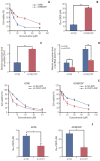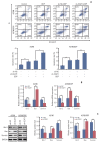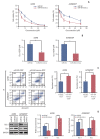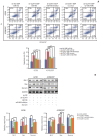Long Non-coding RNA CCAT1 Sponges miR-454 to Promote Chemoresistance of Ovarian Cancer Cells to Cisplatin by Regulation of Surviving
- PMID: 32124583
- PMCID: PMC7373880
- DOI: 10.4143/crt.2019.498
Long Non-coding RNA CCAT1 Sponges miR-454 to Promote Chemoresistance of Ovarian Cancer Cells to Cisplatin by Regulation of Surviving
Abstract
Purpose: Colon cancer-associated transcript 1 (CCAT1) was identified as an oncogenic long non-coding RNA (lncRNA) in a variety of cancers. However, there was a lack of understanding of the mechanism by which CCAT1 conferred cisplatin (also known as DDP) resistance in ovarian cancer cells.
Materials and methods: Cell viability of A2780, SKOV3, A2780/DDP, and SKOV3/DDP cells upon cisplatin treatment was monitored by MTT assay. Quantitative reverse transcription polymerase chain reaction (qRT-PCR) detected the expression levels of CCAT1 and miR-454. The effect of sh-CCAT1 on cisplatin response was investigated in xenografts study. Bioinformatic analysis, luciferase reporter assay and qRT-PCR were conducted to validate the direct interaction among CCAT1, miR-454, and survivin. Apoptosis was determined by flow cytometry after dual staining of Annexin-V-FITC/propidium iodide, and the expression of apoptosis-related proteins Bcl-2, Bax and survivin were detected by qRT-PCR and Western blotting. Xenograft study was conducted to monitor in vivo tumor formation.
Results: CCAT1 was highly expressed in cisplatin-resistant ovarian cancer cell line A2780/DDP and SKOV3/DDP. Knockdown of CCAT1 restored sensitivity to cisplatin in vitro and in vivo. Our data revealed that silencing of CCAT1 promoted cisplatin-induced apoptosis via modulating the expression of pro- or anti-apoptotic proteins Bax, Bcl-2, and survivin. CCAT1 directly interacted with miR-454, and miR-454 overexpression potentiated cisplatin-induced apoptosis. Survivin was identified as a functional target of miR-454, restoration of survivin attenuated the effect of miR-454 on cisplatin response. In addition, miR-454 inhibitor or overexpression of survivin was found to abolish sh-CCAT1-induced apoptosis upon cisplatin treatment.
Conclusion: CCAT1/miR-454/survivin axis conferred cisplatin resistance in ovarian cancer cells.
Keywords: CCAT1; Chemoresistance; Epithelial ovarian carcinoma; LncRNA; Survivin; miR-454.
Conflict of interest statement
Conflict of interest relevant to this article was not reported.
Figures







Similar articles
-
lncRNA CCAT1 is a biomarker for the proliferation and drug resistance of esophageal cancer via the miR-143/PLK1/BUBR1 axis.Mol Carcinog. 2019 Dec;58(12):2207-2217. doi: 10.1002/mc.23109. Epub 2019 Sep 22. Mol Carcinog. 2019. PMID: 31544294
-
LncRNA SNHG1 contributes to the cisplatin resistance and progression of NSCLC via miR-330-5p/DCLK1 axis.Exp Mol Pathol. 2021 Jun;120:104633. doi: 10.1016/j.yexmp.2021.104633. Epub 2021 Mar 19. Exp Mol Pathol. 2021. PMID: 33753110
-
Linc00161 regulated the drug resistance of ovarian cancer by sponging microRNA-128 and modulating MAPK1.Mol Carcinog. 2019 Apr;58(4):577-587. doi: 10.1002/mc.22952. Epub 2019 Jan 22. Mol Carcinog. 2019. PMID: 30556928
-
NEAT1 in Ovarian Cancer: A Key Regulator of Tumor Progression, Follicular Fluid Dynamics, and Therapeutic Resistance.Anticancer Res. 2025 Mar;45(3):825-842. doi: 10.21873/anticanres.17472. Anticancer Res. 2025. PMID: 40037884 Review.
-
Contribution of MicroRNAs in Chemoresistance to Cisplatin in the Top Five Deadliest Cancer: An Updated Review.Front Pharmacol. 2022 Apr 4;13:831099. doi: 10.3389/fphar.2022.831099. eCollection 2022. Front Pharmacol. 2022. PMID: 35444536 Free PMC article. Review.
Cited by
-
Long noncoding RNAs as therapeutic targets to overcome chemoresistance in ovarian cancer.Front Cell Dev Biol. 2022 Aug 29;10:999174. doi: 10.3389/fcell.2022.999174. eCollection 2022. Front Cell Dev Biol. 2022. PMID: 36105363 Free PMC article. Review.
-
circ_C20orf11 enhances DDP resistance by inhibiting miR-527/YWHAZ through the promotion of extracellular vesicle-mediated macrophage M2 polarization in ovarian cancer.Cancer Biol Ther. 2021 Sep 2;22(7-9):440-454. doi: 10.1080/15384047.2021.1959792. Epub 2021 Aug 12. Cancer Biol Ther. 2021. PMID: 34382916 Free PMC article.
-
CCAT1 lncRNA is chromatin-retained and post-transcriptionally spliced.Histochem Cell Biol. 2024 Jul;162(1-2):91-107. doi: 10.1007/s00418-024-02294-w. Epub 2024 May 19. Histochem Cell Biol. 2024. PMID: 38763947 Free PMC article.
-
LncRNA CCAT1 enhances chemoresistance in hepatocellular carcinoma by targeting QKI-5.Sci Rep. 2022 May 12;12(1):7826. doi: 10.1038/s41598-022-11644-4. Sci Rep. 2022. PMID: 35552451 Free PMC article.
-
Analyzing the whole-transcriptome profiles of ncRNAs and predicting the competing endogenous RNA networks in cervical cancer cell lines with cisplatin resistance.Cancer Cell Int. 2021 Oct 12;21(1):532. doi: 10.1186/s12935-021-02239-6. Cancer Cell Int. 2021. PMID: 34641878 Free PMC article.
References
-
- Siegel RL, Miller KD, Jemal A. Cancer statistics, 2017. CA Cancer J Clin. 2017;67:7–30. - PubMed
-
- Oronsky B, Ray CM, Spira AI, Trepel JB, Carter CA, Cottrill HM. A brief review of the management of platinum-resistant-platinum-refractory ovarian cancer. Med Oncol. 2017;34:103. - PubMed
-
- Vergote I, Trope CG, Amant F, Kristensen GB, Ehlen T, Johnson N, et al. Neoadjuvant chemotherapy or primary surgery in stage IIIC or IV ovarian cancer. N Engl J Med. 2010;363:943–53. - PubMed
MeSH terms
Substances
LinkOut - more resources
Full Text Sources
Medical
Research Materials

